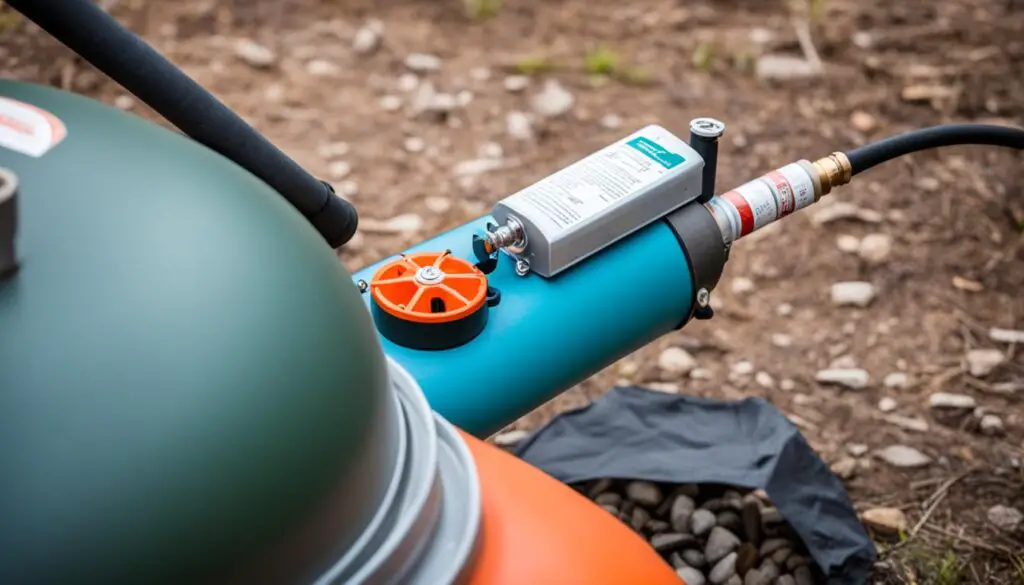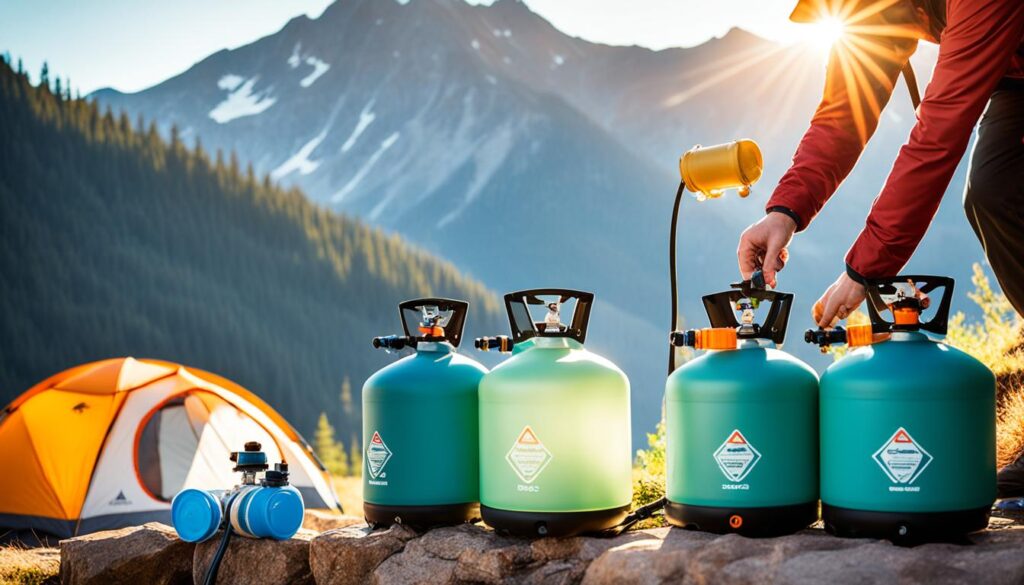Can Camping Propane Tanks Be Refilled
As an avid camper, refilling my propane tanks interests me a lot. These tanks are vital for my outdoor activities. They power my stove, heater, and other gear. Let’s look at refilling these tanks, including safety, rules, and the good and bad of doing it.
Camping propane tanks are loved by outdoor fans. They offer a dependable, portable fuel for camping gear. But, can these tanks be refilled? Or do we need to get new ones? We will find out if it’s possible to refill camping propane tanks.
Understanding Camping Propane Tanks
Camping is a fun adventure outdoors. It often uses propane tanks for cooking and heating. It’s important to know about these tanks for a safe trip.
Types of Camping Propane Tanks
There are many sizes and shapes of camping propane tanks. Each type is good for different camping styles. Here are a few:
- Small, handheld canisters: Great for single campers or those hiking with a stove in their bag.
- Larger, refillable cylinders: These are used for bigger cooking needs, trailers, or group trips. You can fill them up again at special places.
Safety Considerations
Being careful with propane tanks is key. To keep everyone safe, remember:
- Check tanks for damage or leaks before you use them.
- Keep tanks standing up and far from heat and fire.
- When inside or in small areas, make sure air can flow well.
- Do as the maker says when using or removing the tanks.
- Don’t mess with the tank’s safety parts.
Knowing about camping propane tanks and safety tips makes camping fun and safe. It allows you to rely on these tools while looking out for everyone’s well-being.
Refilling Camping Propane Tanks
Regulations and Legalities
Refilling camping propane tanks is smart for saving money. But it’s key to know the laws. Rules for refilling tanks differ by area, so check your local ones.
Safety is a main concern when filling propane tanks. States and cities set rules to keep handling gas safe. These include where and how you can fill tanks and how to store them.
Environmental laws also play a role in refilling propane tanks. Some places limit the propane you can use or how to get rid of old tanks. Not following these rules can lead to fines. Be sure to look up the laws where you live.
| Regulation | Description |
|---|---|
| Safety Standards | Rules for handling, labeling, storing, and moving propane tanks. |
| Environmental Regulations | Rules about the kind of propane and how to throw out old tanks. |
| Permitting and Licensing | Some places need special permits or licenses to fill propane tanks legally. |
Knowing the law helps you refill propane tanks safely. Talk to local experts or propane sellers for advice on following the rules. This can prevent problems and fines.
Can Camping Propane Tanks Be Refilled
Many people who love the outdoors wonder if they can refill their camping propane tanks. This question has many aspects to it. It is important to know these details for a safe and budget-friendly camping trip.
The material and design of the tank are key factors. Tanks are usually either steel or aluminum. Steel tanks last longer but are heavier. Aluminum tanks are lighter but might get damaged easier. The shape of the tank and the type of valve matter too.
Checking if you can refill the tank also involves looking at what the company says. Some tank makers say you can’t refill. Others give rules for refilling safely. Not following these rules can be bad for safety and may even be against the law.
- Camping propane tanks are often designed for single-use and may not be suitable for refilling.
- The tank material and design can impact its refillability, with steel tanks generally more durable but heavier, and aluminum tanks lighter but potentially more susceptible to damage.
- Manufacturer instructions and legal/regulatory restrictions must be carefully reviewed to ensure safe and legal refilling of camping propane tanks.
Figuring out if you can refill your propane tank requires looking at many details. Always check the model and the company’s rules before refilling. This way, campers can make sure they are safe, follow the law, and help the environment.

| Consideration | Impact on Refillability |
|---|---|
| Tank Material | Steel tanks are generally more durable but heavier, while aluminum tanks are lighter but may be more susceptible to damage. |
| Tank Design | The valve type and any safety features can affect the tank’s refillability. |
| Manufacturer Instructions | Some manufacturers may prohibit refilling, while others may allow it with specific guidelines. |
| Legal and Regulatory Restrictions | Failure to adhere to legal and regulatory requirements can lead to safety risks and potential consequences. |
Advantages of Refilling Camping Propane Tanks
Being into camping means always looking for smart ways to enjoy the outdoors. Refilling propane tanks instead of buying new ones brings savings and helps the planet. Let’s check out why refilling your camping propane tank makes sense.
Cost Savings
Refilling your propane tank can save a lot of cash. A 20-pound tank saves you $1.75 per refill, compared to exchange costs of $20 to $25 elsewhere. These savings really add up for those who use lots of tanks.
Users save over $15 each time they refill a 1-pound tank, compared to buying new. Think about the savings over the whole camping season.
Environmental Benefits
Refilling propane tanks is also great for the planet. Every year, 40-60 million disposable 1-pound canisters are sold, creating a lot of waste. By refilling, we reduce the need for new production and disposal of old canisters.
Some places want to ban single-use propane canisters because of this waste. Refilling tanks helps us follow green rules and lessen our camping impact on the Earth.
In summary, refilling your camping propane tank is a smart move. You save money, help the environment, and enjoy the outdoors even more. Responsible campers think about these points and choose to refill their tanks.
Disadvantages of Refilling Camping Propane Tanks
Refilling camping propane tanks can have pros and cons. But there are key disadvantages to think about. There are risks and safety issues to seriously consider. We will look at the main drawbacks of refilling these tanks. This will help you decide the best course.
Potential Safety Risks
One major concern is the safety risks. If you handle or refill propane tanks wrong, it can be dangerous. The risks of refilling propane tanks include fire, property harm, and even injury.
Regulatory Compliance Challenges
It can be hard to meet all the rules when refilling your tanks. The disadvantages of refilling camping propane tanks include dealing with lots of laws. You might need permits or licenses. And you must meet safety rules. If you ignore these, you could face fines or other problems.
Potential for Contamination
When refilling, impurities might get into the fuel. Potential safety concerns with refilling propane tanks are real. Mixing propane with other substances can make the tank less safe. It might not work right, leading to dangers.
| Disadvantage | Description |
|---|---|
| Safety Risks | Improper handling or refilling techniques can lead to leaks, explosions, or other hazardous situations, posing risks of fire, property damage, and personal injury. |
| Regulatory Compliance | Navigating complex legal requirements, obtaining necessary permits or licenses, and adhering to safety standards can be challenging and lead to fines or legal issues. |
| Potential Contamination | Refilling can introduce contaminants or impurities into the propane, affecting the tank’s performance, lifespan, and overall safety. |
After considering the pros and cons of refilling, make a wise choice. Think about the risks, rules, and chance of pollution. These will help you make the best decision for your situation.
Where to Refill Camping Propane Tanks
Refill Stations and Services
Want to refill your camping propane tanks? You need to find the right place. Luckily, many refill stations meet the needs of campers and outdoor fans.
First, check local hardware stores, RV dealers, or propane suppliers. They usually have what you need. They can fill any size tank safely. This way is often cheaper than buying a new tank.
You can also look online for refill kits and adaptors. Flame King and Dozyant are known for these. Their products help you easily refill your camping tanks. These kits come with a tank, a regulator, and the adapters you need.
FAQ
Can Camping Propane Tanks Be Refilled?
Yes, many camping propane tanks can be refilled. But, it’s vital to know safety rules. It depends on the tank’s make and any set rules.
What Types of Camping Propane Tanks are Available?
There are small, handheld canisters to large refillable cylinders. Knowing the tank types and safety rules is key for a safe camp time.
What Safety Considerations Should I Keep in Mind When Using and Handling Camping Propane Tanks?
Safety is always first with these tanks. Proper use, storage, and care help avoid harm. Be sure to read the manual and check local rules on tank use and fill-up.
What Regulations and Legalities Should I Be Aware of When Refilling Camping Propane Tanks?
Refilling rules can differ by place. It’s important to look up local and state rules to refill correctly and legally.
What Are the Advantages of Refilling Camping Propane Tanks?
Refilling has good points like saving money and helping the planet. It cuts buying new tanks often and lessens waste.
What Are the Disadvantages of Refilling Camping Propane Tanks?
Yet, refilling has its challenges. It might need special gear and face legal limits. Thinking through these issues is important for safe outdoor time.
Where Can I Refill My Camping Propane Tanks?
You can refill at stations, service stops, or select shops. Check out local options and rules, paying attention to safety and legitness.
